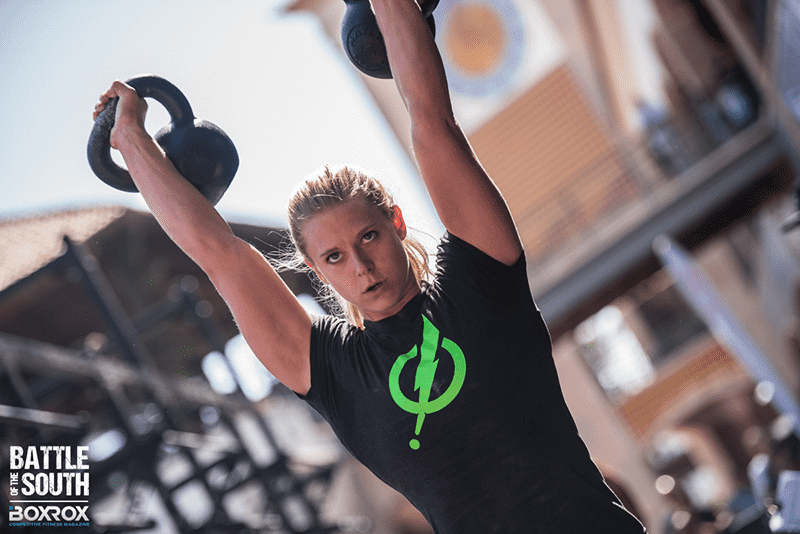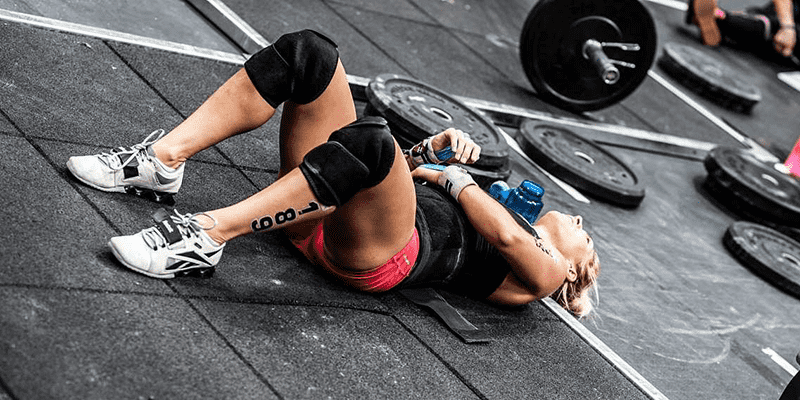This brutal kettlebell WOD (Workout Of the Day) is a fun mix of many exercises divided into three sections, and will likely become a benchmark for anyone who loves a good challenge.
I think we can all agree that there are not enough CrossFit WODs utilising those doorstoppers in the gym called Kettlebells – I’m here to change that.
I’ve created a challenging full body workout utilising kettlebells.
Not only will this kettlebell WOD leave you with that awesome feeling of accomplishment, it will also help you get better at American Swings and Kettlebell Snatches through the Double-arm Swing being programmed in. Remember, the Swing is the foundation for the American Swing and Kettlebell Snatch; if you’ve not mastered the Conventional Swing, then you can’t be efficient at that which builds upon it.
The first part of this kettlebell WOD will challenge every muscle in your body; it requires coordination and planning, as you don’t want to be messing about placing the kettlebells in position.
This part will leave you feeling like you usually do at the end of a WOD, but the great thing is, it’s not over yet, we’re just getting started.
That’s when the Swings come in, you want to test your skills. 6 minutes is a good time to show you’ve mastered the Swing and complete the six minutes without putting the weight down. Pick your weight wisely, not too heavy, but definitely not too light or you won’t get the required resistance you need to properly utilise and activate the lower-body.
Then we finish with a task of 150 reps, again, you want to do this without putting the weight down. This is perfectly possible if your technique is spot on and picked the right weight. You want to pick a kettlebell weight that will leave you struggling to get that one hundred and fiftieth rep out, and then you collapse on the floor, wondering who took your arms.
 Source: RX'd Photography
Source: RX'd PhotographyThe Dudley—Kettlebell WOD
First section – 22 min AMRAP
- 2 x Dead to Overhead and Surrender
- 2 x Renegade Rows
- 2 x Wide Bent-over Rows
- 2 x Archer Push-up L/R
You’re working with two kettlebells, recommended weight is 50 to 65% of your 1RM Row.
1 to 2 minute rest. If you’re hardcore and it’s a piece of cake, forget the rest and move on to your next task.
You can find technique tips and a video with all movements explained at the bottom of this article.
Read more: Add Kettlebell Flow to Your Training and Level-Up Your Fitness
Second section – 6 min AMRAP
- Double-arm Swings
You’re working with one kettlebell, recommend weight is 45 to 55% of your 1RM Swing.
1 to 2 minute rest if you like.
Third section – 150 alternating Strict Presses for time
Working with one kettlebell 50-60% of your 1RM Strict Press.
Quick video to get you amped up about this WOD.
Kettlebell WOD Technique Tips
Be aware, this is an advanced kettlebell workout. I’ll do my best to give you the main pointers on each exercise, but be aware, this article does not cover all intricacies involved with kettlebell training.
Now, I don’t know about you, but I like to see or hear where everyone is at and also like to keep everyone honest. I do that with a whiteboard to put a mark down for every round completed.
I also like shouting out the rounds, but with a lot of people that could get messy, still, better than not knowing where everyone is at.
 Source: RX'd Photography
Source: RX'd PhotographyDead to Overhead and Surrenders
The Dead to Overhead and Surrenders are a full-body exercise with emphasis on the shoulders, back, core and legs.
This is the first exercise of the kettlebell WOD. ‘Dead’ means that the kettlebells needs to start from dead on the ground upon each rep. The reason I’m calling for an Overhead position and don’t define how you should achieve that is because you can decide based upon your skill or preference, for example, it can be:
- Dead- Snatch
- Swing Snatch
- Swing Squat Snatch
- Clean and Press
- Clean and Push Press
- Clean and Jerk
The fastest is the Dead Snatch, but my personal preference is the Dead Swing Snatch.
Because I’ve programmed 150 alternating presses as a finisher for this WOD, you probably don’t want to be Pressing the kettlebells at the start of the WOD.
If Snatching is not your thing, then you should have a go at Jerking or Push Pressing to keep those shoulders from fatiguing early on. Once the kettlebells are overhead, you want to achieve a good lockout by pushing the chest out, pulling your shoulder blades down, and engaging your triceps.
With the good overhead lockout in place you want to brace your core muscles and start lunging back with one leg till the knee is on the ground.
During the lunge backwards:
- make sure the weight stays on the front leg, let the quads do the work
- keep the heel on the ground, if you find that the heel of the front leg comes off the ground then you did not lunge back far enough
- bring the other knee to the ground for a full kneeling position, once there, you come back up by lunging forward with one leg, foot flat on the ground, all the weight on that leg and pressing into the ground to come back up.
Lower your kettlebells into racking position by coming off the heels and meeting the bells, absorbing the weight with the legs; keep the handles close in the midline of your body, if your fingers are away from the handle (racking safety grip[1]) you can even let them cling. From the racking position you do not cast them out, you let them drop as close to your body as possible, stay upright as long as possible and then push the hips back, coming into the back swing and finally lowering them to the ground in-front of you. Repeat two times.
Renegade Rows
The Renegade Row is a full-body exercise with emphasis on the core, rear delts, triceps and lats.
Note: not recommended with anything other than competition kettlebells[2] due to the larger base for stability. Strong core required. Alternative is performing the row with hand on the ground rather than on the handle of the bell.
If you place your bells right on the second rep, which is right in line with your shoulders, then you can smoothly transition into the second exercise, Renegade Rows. With the bells placed in line with your shoulders you put your hands on the handles, the ball of your thumbs on the handle, wrists straight as possible, elbows locked out, kick your legs back into a plank position, with the feet wider than normal, this is to have a better support to row from; if your feet are close together as they normally would be in a plank position, then you would quite quickly see your hips shifting or losing balance.
 Source: RX'd Photography
Source: RX'd PhotographyIn the right position you want to engage all your muscles, your quads for good knee lockout, glutes for neutral pelvic alignment, abs engaged for the spine, lats engaged for the shoulders, everything nicely aligned.
- Perform one Tricep Push-up; if you placed the bells right and your shoulders are directly above the bells, then you’ll find your shoulders coming past the bells on the bottom position of the Tricep Push-up.
- After the Push-up you go directly into a Row, you focus on generating the power to row the bell from your back and your rear delt; do not engage the biceps, let the forearm relax and row into your hip.
- Bring the bell back to the ground, find yourself a stable position with good lockout and balance, then row with the other side. Repeat two times.
Bent-over Wide Rows
The Bent-Over Wide Rows place an emphasis on the middle trapezius, rhomboids, gluteus maximus (isometric) and core (isometric).
After your last rep of the Renegade Rows, the bells should be in place for the third exercise, Bent-over Wide Rows, you simply kick your legs in, you hip hinge, push your belly-button (followed by the spine) and chest out, to get a good neutral spine position.
Your palms are facing backwards, thus you’ve also turned the handles. Squeeze the glutes to protect the lower back, and row by pulling the shoulder blades together, elbows going outwards, 90° between your elbows and ribs.
Let the forearms relax, don’t turn it into a bicep curl. Then return to start position and repeat two times.
Archer Push-ups
The Archer Push-Ups place an emphasis on the pecs and core. You could call it a full body exercise, as whenever you’re in a plank position, you should be isometrically contracting your gluteus maximus, quads, abs, lats etc.
On your last rep of the rows you want to put the bells far apart for the fourth exercise: Archer Push-ups.
- One arm is completely straight and hand placed on the bell. Come into push-up position and perform a push-up while focussing on one side only, the side with the hand on the ground.
- Try not to push into the bell with your straight arm, but aim to perform the Push-up with all the power coming from the working arm. This is a great progressional exercise to the one arm push-up.
Most of the time I don’t count unfinished rounds, I like this because it will allow you to pace properly and get a feeling for timing and plan. So, even if you’re on your last rep of archer Push-ups and the timer goes, no round buddy! Ultimately, it’s up to you what you decide to do here.
If you do count incomplete rounds, mark it as /r/e/r which is Round, Exercise and Rep, for example: 18.3.1 equals 18 rounds, 3 exercises completed and 1 rep on the fourth exercise.
Double-arm Swings
Also known as Russian Swings or Conventional Swings.
Have up to two minutes rest, set the timer for a 6 minutes count-down and start your next exercise: the Double-arm Swings to chest height.
I could write a book about the swing – in fact, I have – but if there is anything that will help you swing better and protect your back, then it’s the following points:
- At the top of the swing, full hip extension, active core, chest out, let the bell drop back down about a quarter of the way, then break at the hips and follow through with either a pendulum or insert.
- Wait for the bell to want to come back out, then push the heels into the ground to truly activate the hamstrings and squeeze the glutes at the same time.
These last two tips will greatly help protect the lower-back and prevent lifting with the back—letting the back lead and pelvis follow.
A good swing should never get you in the lower-back.
In this workout I completed 207 swings with a 18kg, non-stop. Anna did 217 with a 16kg non-stop, neither of us have any problems with our lower-back, in fact, if you do this right, you should feel it in your glutes and hamstrings.
Alternating Strict Press
Two minutes or less rest, and set the time to go up, as the next part is FOR TIME, i.e. how fast can you complete the task. The task is to complete 150 Alternating Strict Presses, how you switch hands upon each rep is up to you.
If you’re good at swinging (hip hinging), then swing switch, if you prefer a more explosive squatting movement, then go for the Dead Clean, i.e. you put it down on the ground, switch hands and Dead Clean into Press.
You need to pick your weight smartly, as you want to keep the pace going for all 150 reps and these are strict presses, so NO Push Press or any power generation with the legs. Make sure you get a good overhead lockout or NO REP. Go with about 50 to 60% of your Strict Press in weight.
- Start your first rep from the ground with a Dead Swing Clean, straight into a Strict Press, then bring your body closer to the weight by coming on the balls of your feet, heels off the ground, take the impact with your legs.
- Stay upright, let the bell fall down approx. a quarter of the way, then hip hinge and let the bell come through the legs.
- Perform a good Swing, end with the thumb pointing upwards at the top of the Swing (approx. chest height) and switch hands, let the bell come through the legs and Clean the kettlebell.
- Think about all aspects of a Swing with your clean, but keep the bell closer to the body with the Clean, time it right, get the height right and your hand should just smoothly insert.
- Try and complete it without putting the bell down at all, it’s possible! If your WOD music is banging, your frame of mind is right, you get into the rhythm and it starts to feel like dancing, you know you’re doing it right.
The Dudley is a kettlebell WOD we do regularly, now you will too, so make sure to post your results on our Facebook[3]. You can also ask questions there if you want to clarify anything.
Watch the video with the exercises from two angles below.
[1] Check out our free kettlebell grip document, search Google for ‘Cavemantraining Kettlebell Grips’, it will show you details on the racking safety grip and other grips you should implement during kettlebell training
[2] Kettlebells USA sell great comp bells and sometimes offer free shipping
[3] Cavemantraining Facebook facebook.com/cavemantraining
Image Sources
- kettlebell-workouts-male-crossfitter: RX'd Photography
- kettlebell-workouts-female-crossfitter: RX'd Photography
- recovery-position: RX'd Photography
- kettlebell-crossfit-athlete: RX'd Photography
